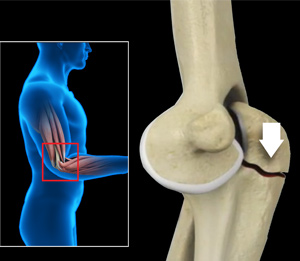What is Elbow Fractures?
Elbow fractures occur when the bone of the elbow breaks. Elbow joint is formed when three bones meet together. The humerus (the upper arm), the radius( forearm bone), and ulna( another forearm bone). Elbow fractures are also called olecranon fractures occurring commonly due to less protection from muscles around it.
Types of Elbow FracturesSome types include:
Clavicle Fractures:
- Radial head and neck fractures.
- Olecranon fractures.
- Fractures of the distal humerus.
Symptoms OF Elbow Fractures
The patient is unable to bend the elbow in case of elbow fracture. Symptoms of elbow fractures include:
- Deformity
- Pain
- Swelling
- Bruising
- Numbness
- Tenderness
Pathology: A fracture of the radial head and neck or olecranon or fracture of the distal humerus of bone caused by a direct or indirect force.
Causes of Elbow Fractures
There are a variety of causes of elbow fractures though weaker bones or osteoarthritic bones are more prone to fractures. Other causes are:
- Severe trauma
- Falling on an outstretched hand
- Twisting injuries
- Car accidents or motorcycle accidents
- Falling on an outstretched hand
- Direct contact sports
- High impact sporting activities
Diagnosis Of Elbow Fractures
X-rays: X-ray images show the fractured site. Also helps to determine whether the bone is broken or else the surface is only affected.
MRI: If the elbow is fractured, the injury may affect the tendons, ligaments, or nerves. With the help of MRI, we can see a detailed image of the soft tissue, torn or strained ligaments or tendon, and whether the nerve is compressed or not.
CT scans: CT scan reveals the location of the fracture or whether the bones are broken or not.
Treatment Of Elbow Fractures
Early diagnosis and treatment improves recovery. Depending on the severity of the fracture, a splint or a temporary cast may be used for immobilization to position the bones in place. In severe cases, internal fixation like screws, wires, or plates, often done might be surgically implanted to mend the fracture. Healing time typically takes about 8-12weeks.
Mobilization with physiotherapy is begun immediately after surgery once it is pain-free.
Conservative Treatment For Elbow Fractures
Medications: Codeine, Acetaminophen, Tylenol, Cetafen, etc.
Note: Medication should be taken under the prescription of the doctor.
Physiotherapy Treatment For Elbow Fractures
Non-operative treatment such as using a sling, cast, or splint is typically used when the bones are at low risk of displacement.
Immobilization: It involves casting or immobilization for 4-6 weeks, followed by mobilization and physical therapy. Temporary cast or sling with no mobility for the 4 -6 weeks is done. Physiotherapy is directed to increase motion and decrease the chance of getting elbow stiffness.
Range of motion exercises: To slowly increase the elbow range of motion physiotherapy is started by recommending weekly exercises. Activities to increase joint motion, muscle strength, and flexibility are started. These include passive range of motion exercises, active range of motion exercises such as pendulum exercises, shoulder wheel, pulleys, finger ladder, etc should be started.
Cryotherapy: Cryotherapy is given to decrease the swelling.
Thermotherapy: Thermotherapy accelerates the rate of healing of fractures.
Ultrasound: Ultrasound therapy is used to speed up the healing of broken bones. It also decreases the inflammatory response, which reduces swelling and decreases pain.
Strengthening exercises: Strengthening exercises include isometric exercises, range of exercises with minimal resistance gradually increases to maximal resistance exercises, and exercises with weights
Functional exercises: Exercise training so that the patient can return to work and actively do the daily activities.
Patient Education
The patient's cooperation is necessary to promote the healing process. The patient must follow the exercises regime on daily basis as prescribed by the physiotherapist.


